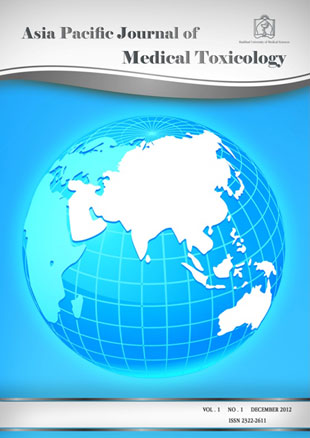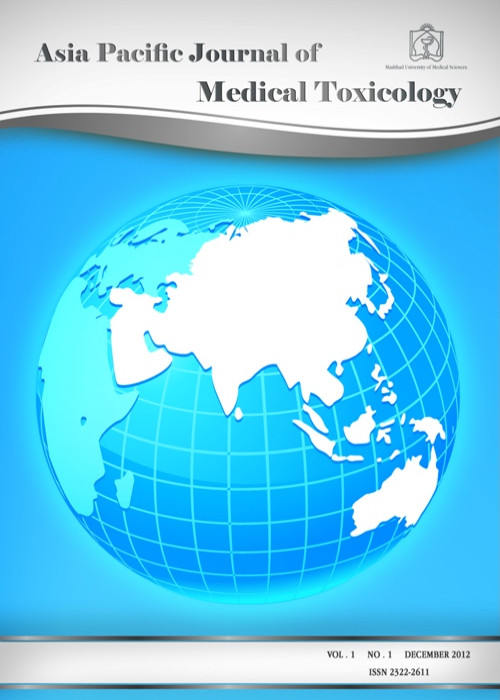فهرست مطالب

Asia Pacific Journal of Medical Toxicology
Volume:1 Issue: 1, Autumn 2012
- تاریخ انتشار: 1391/11/09
- تعداد عناوین: 9
-
-
Page 3BackgroundCaustic substance ingestion is known for causing a wide array of gastrointestinal and systemic complications. In Russia, ingestion of acetic acid is a major problem which annually affects 11.2 per 100,000 individuals. The objective of this study was to report and analyze main complications and outcomes of patients with 70% concentrated acetic acid poisoning.MethodsThis was a retrospective study of patients with acetic acid ingestion who were treated at Sverdlovsk Regional Poisoning Treatment Center during 2006 to 2012. GI mucosal injury of each patient was assessed with endoscopy according to Zargar’s scale. Data analysis was performed to analyze the predictors of stricture formation and mortality.ResultsA total of 400 patients with median age of 47 yr were included. GI injury grade I was found in 66 cases (16.5%), IIa in 117 (29.3%), IIb in 120 (30%), IIIa in 27 (16.7%) and IIIb in 70 (17.5%). 11% of patients developed strictures and overall mortality rate was 21%. Main complications were hemolysis (55%), renal injury (35%), pneumonia (27%) and bleeding during the first 3 days (27%). Predictors of mortality were age 60 to 79 years, grade IIIa and IIIb of GI injury, pneumonia, stages “I”, “F” and “L” of kidney damage according to the RIFLE scale and administration of prednisolone. Predictors of stricture formation were ingestion of over 100 mL of acetic acid and grade IIb and IIIa of GI injury.ConclusionHighly concentrated acetic acid is still frequently ingested in Russia with a high mortality rate. Patients with higher grades of GI injury, pneumonia, renal injury and higher amount of acid ingested should be more carefully monitored as they are more susceptible to develop fatal consequences.
-
Page 10BackgroundChildhood poisoning is a significant international health concern. Very little is known about trends in exposures within schools and preschools. The objectives of this study were to investigate the data recorded by the New Zealand National Poisons Centre (NPC) on these types of exposures over a 21 year period (1989 to 2009) and to determine trends and propose strategies to reduce the exposures.MethodsCall information regarding human poison exposure at preschools and schools from Jan1st 1989 to Dec 31st 2009 were extracted from the dataset held by the NPC. The number of calls received by the NPC relating to the exposures was plotted against year as totals and then categorized according to gender. The number of calls related to each substance type for each year, and the number of calls related to each age group for each year were quantified.ResultsThere were 3632 calls over this period. In every year studied, there were more calls relating to males than females. Household items were responsible for 31% of exposures, followed by plants (20%), industrial items (14%) and therapeutic agents (14%). Almost one quarter of all exposures occurred in the 13 year old age group. Further investigation of this group, showed that the causes of exposures included “splash” incidents (27%), “pengestion” (pen breaking in mouth and releasing contents) (16%), “exploratory” (5%) and “prank” (4%).ConclusionIdentification of these areas allows recommendations to be made including feedback to teachers about exposure risks, storage and access of science, cleaning and art supplies.Keywords: Poisoning, Childhood, Adolescent, Poison centre, School
-
Page 14BackgroundAluminum phosphide is the common cause of poisoning in adults in India, with a very high case fatality ratio. We studied five patients of aluminum phosphide poisoning with polyserositis.MethodsWe enrolled all patients with aluminum phosphide poisoning presenting to emergency medical department, at a tertiary care hospital in northwestern India from January to July 2006. These patients were managed according to a standard treatment protocol and their complications were recorded.ResultsDuring the study period, total of 35 patients were admitted with 57.5% mortality in the first 12 hours. Among the rest, 5 patients were found to develop polyserositis. All these patients had severe hypotension at presentation and developed respiratory distress requiring mechanical ventilation after an average stay of 3.8 days post-ingestion. They were managed conservatively and four of them were discharged from the hospital after the average stay of 10 days.ConclusionIn this case series, features of polyserositis (pleural effusion, ascites and pericardial effusion) were found in 15% patients of severe aluminum phosphide poisoning. We postulate systemic capillary leak syndrome, secondary to mitochondrial damage in the endothelium, as a possible mechanism.Keywords: Systemic capillary leak syndrome, Endothelial dysfunction, Phosphine gas, Aluminum phosphide, Polyserositis
-
Page 18BackgroundSnakebite is the most important cause of envenomation in South Asia particularly in Bangladesh, though there is lack of data from the rural part of the country. About 82 species of snakes (28 venomous) exist in Bangladesh. In this study, demographic characteristics of the victim, circumstances behind the bite along with pre-hospital and hospital managements and outcomes were evaluated.MethodsIt was a cross-sectional study during January 2010 to June 2012 at Rangpur Medical College Hospital. Only venomous snakebite cases were included and diagnosis was made on clinical syndrome. Descriptive statistics were presented using percentage and proportion.ResultsOut of 28 patients (mean age: 31.7 years), 20 (71.4%) were males with a significant male-female ratio (2.5:1). Majority were farmers (46.4%) and most (50%) of the bites happened during household activities. Lag period between bite and hospitalization was ≤5 hours in 50% patients; 6 to 10 hours in 39.2% and >10 hours in 10.7% cases. 82.1% patients received ligature as pre-hospital first aid. Total 21 patients received anti-snake venom (ASV) in different dose regimens. 15 (53.5%) patients recovered while 13 (46.4%) died. Among 13 patients who died, 53.8% died within 2 hours, 15.3% within 3-24 hours and 30.7% after 24 hours post-bite.ConclusionSnakebite has a significant impact on human health and economy through treatment-related expenditures and loss of productivity. Policy makers of Bangladesh should prioritize the issue to reduce future mortality and morbidity.Keywords: Poisoning, Snakebite, Bangladesh, Envenomation, Management
-
Page 22BackgroundSri Lanka became a signatory to the WHO Framework Convention on Tobacco Control in September 2003 and ratified in November 2003. Aiming to reduce tobacco burden in Sri Lanka, National Authority on Tobacco and Alcohol Act [NATA] No. 27 was authorized in 2006. The objective of this study was to assess the behavioral changes related to tobacco use among adolescents and young adults following the exposure to tobacco control measures implemented by NATA.MethodsA cross-sectional survey was conducted from October 2011 to November 2011 among adolescent (13-19 years) and young adult (20-39 years) males in Anuradhapura divisional secretary area in Sri Lanka. A self-administered questionnaire and focus group discussions were used for data collection. Confounding factors were controlled by stratification and randomization.ResultsA total of 456 male respondents including 168 (37%) adolescents and 288 (63%) young adults participated in the study. Among the ever smokers 66 (14 %) had already quitted smoking while 151 (33%) were current smokers. The majority of the respondents (95.4% of quitters and 88.0% of current smokers) were acquainted with the dangers of smoking through the mass media. Among the current smokers and quitters, the knowledge on health risks of smoking and exposure to secondhand smoke was quite satisfactory. The current smokers as well as the quitters were well aware of the tobacco control measures. Smokers as well as the non-smokers and quitters supported these measures.ConclusionTobacco control measures implemented by NATA had a favorable influence on reducing tobacco burden among adolescents and young adults in Sri LankaKeywords: Tobacco control, Adolescent, Young adults, NATA, Sri Lanka
-
Page 27BackgroundThe goal of antivenom administration for snake-bitten patients is to achieve therapeutic response (initial control), which means reversal of the venom-induced effects through neutralizing the venom. The aim of this study was to identify snakebite prognostic factors of weak therapeutic response prior to antivenom administration.MethodsThis was a retrospective study of patients with viperidae snakebite envenomation who were admitted to Mashhad Toxicology Centre during 2007-2011. Demographic features, clinical manifestations and snakebite severity score (SSS) were collected prior to antivenom administration. Total number of antivenom vials administered to achieve therapeutic response and duration of hospitalization were also recorded. Potential factors in snakebite prognosis were analyzed by comparing in two groups of achieving therapeutic response with less than 5 vials and over 5 to calculate odds ratio.ResultsTotal of 108 patients (male/female: 85/23) with mean (SD) age of 34.5 (17.0) were studied. The most common manifestations included fang marks (100%), pain (100%), ecchymosis (89%), swelling (83%), blister formation (48%) and thrombocytopenia (25%). In univariate analysis, thrombocytopenia (P=0.01), spontaneous bleeding (P=0.02), coagulopathic disturbances (P=0.007), swelling (P=0.003), progressive swelling (P=0.005), ecchymosis (P=0.05) and respiratory distress (P= 0.05) were significantly correlated to weak therapeutic response. Swelling and spontaneous bleeding were the strongest snakebite prognostic factors, as respectively they put the patients at 12.4 and 10.4 fold risks for difficult achievement of therapeutic response.ConclusionsIn snakebite, some clinical manifestations in the first hours of admission and prior to antivenom administration are associated with weak therapeutic response. Identifying these prognostic factors, can assist health care providers to better estimate the patient’s needs and predict the final consequences.Keywords: Snakebite, Prognostic factor, Thrombocytopenia, Therapeutic response, Initial control
-
Page 34BackgroundDuring the one-year period from May 2008 to May 2009, a nationwide shortage developed which rabies vaccine was not being produced by the manufacturers. In order to manage existing supply, a protocol was established wherein an authorization was required from the regional poison center before vaccine could be administered to a patient.MethodsThe Georgia Poison Center internal database was accessed for information pertaining to rabies exposure calls for the time of the restriction, as well as the years before and after. Results were examined for the total number of human rabies exposure calls received by the poison center, as well as the number of cases in which PEP was recommended.ResultsDuring the restriction period, the number of rabies-related calls increased, while the percentage of cases in which PEP was recommended, remained consistent. The year following the restriction, the number of rabies related calls remained elevated.ConclusionOur Regional Poison Center was able to make a positive impact by reducing unnecessary use of PEP in a time of shortage and thereby ensuring that all patients who needed the vaccine were able to receive it. This further shows the potential capacity of the poison information centers to optimize healthcare services.Keywords: Rabies, Post, exposure prophylaxis, Medication shortage, Poison center, Public health


